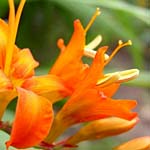Plants for autumn colour
Alan Titchmarsh says you don’t need to limit the best of your colour to June and July – many plants will give your garden a lift until the end of October


If you want to buy any of the plants mentioned below for your own garden, visit www.countrylife.co.uk/nursery and type or copy and paste the name into the search. Plants are delivered in sturdy boxes in a matter of days from one of the finest nurseries in the country.
It was H. E. Bates who revelled in a garden that came into its own in late summer and early autumn, confessing that he took great delight in both the summer-long anticipation and the fact that it was at its peak when the gardens of others had gone over the hill. The reason that most of us have gardens that are at their colourful best in June and July is that these are the months when the majority visit garden centres, nurseries and plant fairs. We buy things that are in flower, not unreasonably, so we can see what we're getting. In subsequent years, our gardens offer the richest pickings in the early summer months.
But it's a mistake to shop for plants only at the start of summer. In August, September and October, there are bargains to be had in garden centres, which recognise that the peak buying season for perennials is past, but need to shift their stock. Buy herbaceous plants in bloom now, and you're generally assured of value for money as well as late-season colour; planted now-the soil is still relatively warm-the plants will establish well before the onset of autumn proper. The policy is one I've observed myself this year, filling gaps that have been created by pulling out over-extended clumps of earlier-flowering perennials.
Few are brighter than the plant that grew weed-like under our privet hedge when I was a boy-montbretia. The one that my mother had was the familiar orange sort, but now there are dozens of varieties with flowers that may be anything from pale lemon yellow to deep red. Gardeners have also taken to calling them by their proper name-Crocosmia. The variety that is most frequently grown nowadays is scarlet Lucifer, but it's a tall plant that topples in my borders if not given some kind of support, and here, it's all but over by August. Through September and into October, I have been enjoying the rich-yellow Crocosmia George Davison, large-flowered orange Emily Mackenzie and reddish-orange Carmin Brilliant, all of which seem more than capable of supporting themselves, and their attractive, sword-like leaves are not as large or coarse as those of Lucifer. Sun and well-drained soil is what they enjoy.
These crocosmias will not carry on right through October, but flowers of the sedums will: the common-or-garden ice plant, Sedum spectabile, or the more recently popular Sedum Matrona, with its purple-flushed leaves. It matters not which one you grow-the bees love them for their nectaries, and, in a year when butterflies have made scarcer appearances than I can remember, nectar-rich plants have become even more important.
Butterflies love Michaelmas daisies, too. Not for me the old dusky grey-lilac sort that were stalwarts of the railway embank-ment, their leaves a martyr to dusty white mildew; I plant the New England asters with their greater vigour and brighter blooms. Few are more brilliant than Aster novae-angliae Andenken, an Alma Pötschke, whose flowers are a startling cerise pink, carried in generous numbers on plants about 3ft tall. Put her at the back of a border and she'll make a deep green backdrop for most of the summer before bursting into flower.
Then, there are the dahlias. Time was when they would be frosted by September, but, these days, they will often not be blackened until late October or even November, and, if regularly cut for the house, they'll go on and on until the weather decides otherwise. Dahlias are greedy, being thick and fleshy-their stems and foliage give away the level of their hunger and thirst. In organically enriched soil that doesn't dry out and which has been generously dusted with fertiliser or treated to weekly liquid feeds, they'll thrive until Jack Frost strikes.
Exquisite houses, the beauty of Nature, and how to get the most from your life, straight to your inbox.
Add to these reliable old stagers the autumn daisies-rudbeck-ias and heleniums, with their yellow, orange or mahogany-coloured flowers, the wonderful shrubby salvias, such as scarlet-and-white Salvia Hot Lips, and a host of pink-flowered diascias that refuse to give up flowering until the real chill of autumn arrives-and you too will revel in the same kind of pleasure that was enjoyed by the creator of The Darling Buds of May. The darling buds of October are every bit as good at lifting the spirits.
* Subscribe to Country Life and get our Ipad edition for free:
Country Life is unlike any other magazine: the only glossy weekly on the newsstand and the only magazine that has been guest-edited by His Majesty The King not once, but twice. It is a celebration of modern rural life and all its diverse joys and pleasures — that was first published in Queen Victoria's Diamond Jubilee year. Our eclectic mixture of witty and informative content — from the most up-to-date property news and commentary and a coveted glimpse inside some of the UK's best houses and gardens, to gardening, the arts and interior design, written by experts in their field — still cannot be found in print or online, anywhere else.
